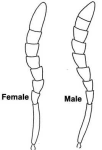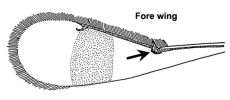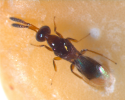 |
Scientific nameTheocolax elegans (Westwood) (=Choetospila elegans Westwood, Chaetospila elegans)
Taxonomic positionHymenoptera: Chalcidoidea: Pteromalidae: Cerocephalinae
DiagnosisBody outline elongate, head and mesosoma (thorax) dorsally more or less dark brown, abdomen
dark pitchy brown to black; antennal scape reddish to yellowish brown, next three or four segments darker reddish brown, club dark brown to black; legs yellowish brown, fore and hind coxae somewhat lighter and whitish, middle coxa brown, outer margin of femora darker, brownish. Head dorsally depressed, elongate and somewhat tapering towards apex. Antennae inserted distinctly forwards, antennal insertions anterior to posterior margin of eyes; eight-segmented in female and nine-segmented in male (Fig. 1). Mesosoma
(thorax) smooth and shiny, without any sculpture. Fore wing (Fig. 2) with a distinct tuft of hairs at base of marginal vein, fuscous in the middle, margins very densely and conspicuously fringed with long hairs. Occasionally wings shorter or absent.
 Fig. 1. Antenna Fig. 1. Antenna Fig. 2. Fore wing venation Fig. 2. Fore wing venation
ImagesDistribution
A cosmopolitan parasite of small beetles developing in stored grain (Boucek, 1988). India (Arunachal Pradesh; Delhi; Karnataka; Kerala; Tamil Nadu). Bangladesh. Pakistan. Widely distributed in the Oriental and Australasian regions and the Americas (Noyes, 2006).
Hosts / Associated habitat / BiologyTheocolax elegans (Westwood) is a cosmopolitan pteromalid wasp that parasitizes Rhyzopertha dominica (Coleoptera: Bostrichidae) and other stored grain beetles such as Sitophilus
oryzae (L.), S. granarius (L.), and S. zeamais Motschulsky (Coleoptera: Curculionidae).
This wasp only parasitizes larvae that are feeding inside the grain kernel (van den Assem and Kuenen, 1958). Noyes (2003) has listed all the host insects recorded worldwide.
Ahmed & Khatun (1993) studied its biology. The adults are very small (1-2 mm), and do not feed on the grain. They normally die within 5-10 days if no hosts are present in the grain. Because the adult wasps are external to the grain, they can easily be removed from it using normal cleaning processes. These parasitoids are found naturally in stored grain, which suggests that once released they may continue to suppress pests for many years. References
|




